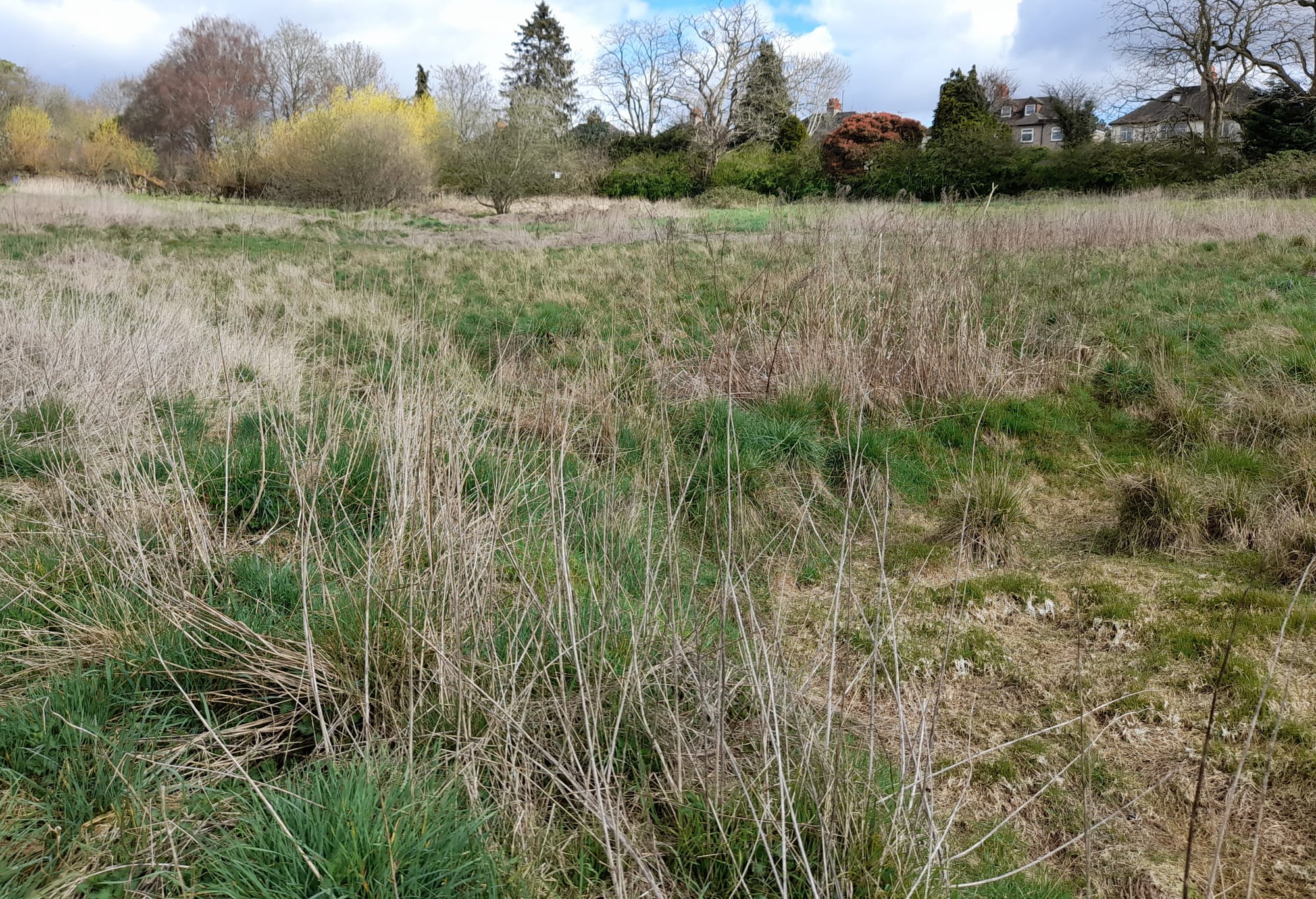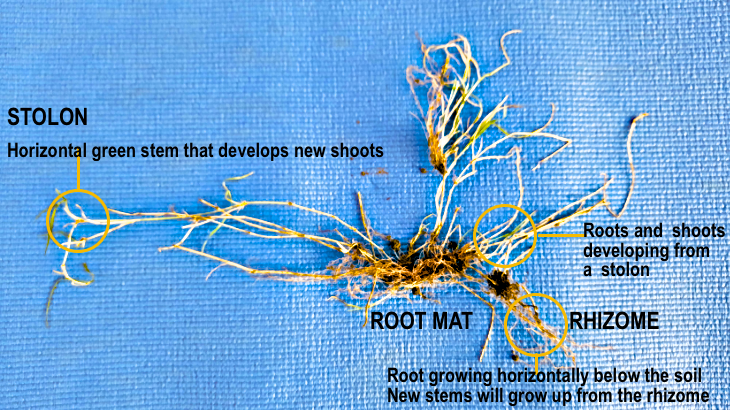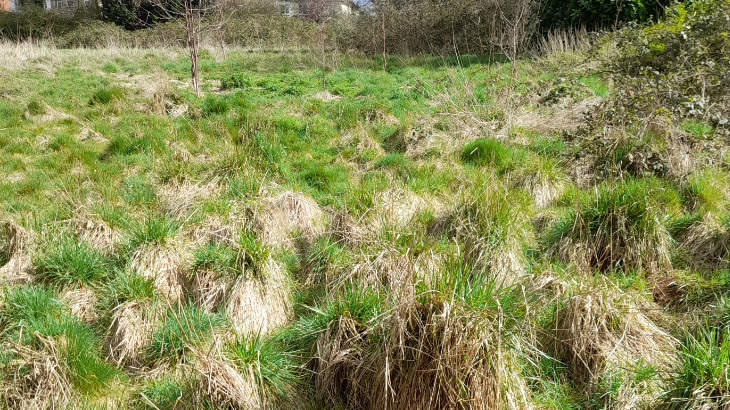A Journey Through Grass

Members of CA-WN are involved in a grassland project, which aims to draw attention to the nature recovery potential of areas of grassland from road-side verges to small meadows. As a member of this group I considered it worthwhile to explore the importance of grassland and its relationship to humans. There could be many chapters as we progress from an evolutionary history of grassland to the individual grass species in our lawns:
Writing about grass is therefore a journey of many dimensions.
A JOURNEY THROUGH GRASS
Palaeontology influences investigations into the evolutionary origins of grasses.
Prehistoric grasses are thought to date back to the Cretaceous period - a geological period that began 145 million years ago and ended 66 million years ago. Our planet's continents, once joined together as one supercontinent called Pangea, had begun to drift apart and by the Cretaceous were more or less in their present-day positions. However, the Earth was a lot warmer than it is today and there was little or no ice at the North or South Poles.1 Temperate rainforest grew close to the poles, and included trees such as the Chilean Pine, Araucaria Araucana, or as most of us know it: the Monkey Puzzle tree. There is one growing perfectly happily in a neighbour’s garden; astonishing to imagine it providing food and shelter for T. Rex and Pterodactyls in the Cretaceous! Other familiar trees of our parks and gardens with Cretaceous provenance are cycads (tree ferns), redwoods (sequoia species) and gingko species. There are several gingko trees in Abington Park, Northampton.
The Cretaceous period saw the evolution of the largest ever dinosaurs, the sauropods in the southern hemisphere1 and while they were reptilian, their grazing behaviour was redolent of modern mammal herds of the expansive savannah or prairie landscapes across our continents. A puzzle for palaeobotanists has been: did dinosaurs eat grass? It was thought that Cretaceous grazing landscapes were dominated by ferns and cycads which the ‘vegesaurs’ ate, but in 2005 a discovery in India of coprolites (fossilised animal dung) from the late Cretaceous period showed stems of grass and moreover a diverse assemblage of grasses (Bristol project 2011)2. A coprolite provides the ‘hard minimum’ – fossilised evidence of the existence of grass in the late Cretaceous, and demonstrates that some dinosaurs did feed on grass. It is acknowledged that the diversity of grasses was poor but other flowering plants were evolving at this time and with them insects. It was a massively productive time evolutionarily, but which ended suddenly with the ‘mass extinction’ of 78% of species on the planet 66 million years ago when a giant asteroid hit the earth somewhere off the east Mexican coast1.
Grass species survived along with many plant groups. Plants are better able than animals to survive catastrophe, as they can regrow from rooting systems, buds and other parts.
Plants also have the advantage of creating vast quantities of seeds that, in some cases, can survive in the soil for decades until conditions are right for them to begin to grow.
Ecological variation within groups also helps in the face of catastrophe. Plant families like the grasses produce a huge variety of types for all soils and climates and have annual and perennial varieties. Grasses like most plants are resilient and adaptive.
So: What is the grass? What is its biology?
Walt Whitman, the American poet, writes in answer to the question posed by a child “What is the grass?”, following a number of musings in his poem ‘The Leaves of Grass’: “Or I guess the grass is itself a child. . .the produced babe of the vegetation”. We will see though, that grass, rather than being a forerunner of trees or a ‘babe’ of other vegetation, is very independent and dictates its own ecosystem organisation!
Grasses belong to the Grass Family, a group of plants with the scientific name Poaceae or Graminae3.
Grasses are the fifth-largest family of angiosperms (flowering plants), existing all over the world and in very different conditions – wet, dry, cold and hot. This family can be divided into 2 groups or clades*: the BOP clade which contains more cool temperate species, and the PACMAD clade which is warm temperate or tropical. Both terms BOP and PACMAD are mnemonics of their subgroup names3.
What is interesting is that both clades have links to early grass evolution and diversification. The BOP clade contains a subgroup with rye grass, wheat and barley, another of bamboo species and another of rice and wild rice. The PACMAD clade includes maize, sorghum, sugar cane and pampas grass. This means that the cereal grasses which are now grown commercially on what would have been natural grassland whether prairie, steppe or savannah, are related genetically to paleo grass species! Imagine sharing a bowl of cornflakes with a Late Cretaceous Triceratops.
It is important to note that grasses are angiosperms (flowering plants) but are monocots which means they have one starch store or cotyledon in the seed embryo. A monocot plant grows from a single stem base and the roots grow vertically down from the stem forming a fibrous mass. Monocot leaves are blades growing up from the stem. Grasses are adapted to the effects of wind and heat in open spaces which increases evapotranspiration. The blade leaf shape protects against moisture loss. All grasses are wind pollinated and produce lots of seed to ensure seed dispersal. They also have rhizomes and stolons which enable them to spread vegetatively4.

The structure of a single grass stem is important and in association with a myriad of varieties of these monocots, grassland becomes a foundational layer – a protector of the soil. The root depth of individual species varies, so forming a deep mat to protect against temperature and moisture changes and therefore soil erosion. There is a species of American prairie grass, Sorgastrum nutens, for example, that reaches 4.6 metres below the surface3. With other deep rooting grasses in association the prairies are responsible for their own survival against intense weather systems such as tornadoes or snowfall and because their growth emanates from a single stem at soil level with the majority of their carbon stored below ground, they are adapted to the fires that can also whip through. They grow back from the same stem. A fire would be the equivalent of a lawn mower cutting a lawn.
About 90% of the carbon stored by grasslands is in roots and soil carbon5. This underground storage means that when grasslands burn or are grazed, the carbon they store remains largely intact. Managed burning and grazing can promote grass growth, leading to increased carbon storage. Julia Rosen, an environmental writer and journalist, notes that “grasslands store less carbon per acre than forests, on average, but in a volatile climate, they can often store it longer.”9. As well as the storage of carbon, grasslands exert a strong influence on global climate regulation through atmospheric cooling due to their high surface ‘albedo’ effect which is their ability to reflect light6.
The human dimension
Ten million years ago, grasslands covered one third of the globe. Homo sapiens evolved in and around the savannahs of Africa. Julia Rosen states ‘we are grass people’9. There is evidence of tropical grass species from leaf fossils or phytoliths and micro-fragments of charcoal in the lake sediments of the Turkana Basin in Kenya, where Homo species evolved8. This indicates that early Homo species had to adapt to natural wild fire events as they roamed the grasslands.
The expansion of grassland and the migrations of early humans seem to be simultaneous.
In her article ‘Trees are overrated’9, Rosen suggests there is cultural bias and scientific confusion in researchers’ attitudes to grassland: that European scientists prefer forests and have undervalued grasslands and have assumed that successional processes will always progress to tree cover in any ecosystem that could support trees. Joseph Veldman of Texas University described this as ‘arboreal chauvinism’ (2015), or ‘the tyranny of trees,’ but his research did confirm that grasslands are distinct ecosystems sustained by their own versions of ecosystem processes9. He explained that old-growth grasslands are like ancient forests and take centuries to build up biodiversity and carbon stores. We can recognise how important grasslands are to biodiversity since we all understand that they support life, ranging from megafauna such as lions and elephants to pollinators and wild flowers. A mountain grassland in Argentina holds the record for the most plant species found within a square metre of land: 89.
The work of Julia Rosen and Joseph Veldman is worth reading providing many case studies of grassland restoration and nature-based management strategies7. They both question the attention now given to grasslands as providing carbon credit scores for offsetting in the same way that land is bought up by corporations for tree planting as a means of carbon offsetting10.
Their work focuses attention to the value of any swathe, verge or field of grass as potential for nature recovery in any locality. However, one challenge is cultural bias in the perceptions we have of what is aesthetically pleasing, whether urban green spaces or rural landscapes.

I attempted some years ago to ‘rewild’ a verge in the village where I live. It was a naïve effort. From April to June the field poppies were stunning – it became a show of annual wild flowers with some clover and people loved it until by July and certainly August, a brown weedy unkempt and ragged collection of decay and death resulted in a meeting in my absence and a decision to mow back and revert to the acceptability of a neat green border to the road!
However, in terms of biodiversity and the nature recovery target of 30% improvement by 2030, restoring grasslands of any size or nature is vital. The importance of grass species for climate mitigation and carbon sequestration is better known now and research is ongoing. Our task could be to view those swathes, verges, lawns, gardens, parks and fields as potential projects for nature recovery. We examine what is there, identify the grasses and other plants, consider the insect and other life they support, and plan to expand and improve. Every grassy area can be re-imagined as a potential site for nature recovery. In this way the ‘babe of vegetation’ is the beginning of the journey to nature recovery through grass.
*A clade is a natural group of organisms with one common ancestor and all descendants from that one (mono) ancestor. A clade can also be called a monophyletic group.
REFERENCES
1. https://www.nhm.ac.uk/discover/the-cretaceous-period.html
2. https://research-information.bris.ac.uk/en/publications/the-bristol-dinosaur-project
3. https://evolution.earthathome.org/grasses/diversity
4. https://bowls-central.co.uk/how-grass-works/
5. Grassland soil carbon sequestration: Current understanding, challenges, and solutions. Science 377, 603–608 (2022)
6. https://www.cell.com/current-biology/fulltext/S0960-9822(21)00889-7
8. https://www.frontiersin.org/journals/earth-science/articles/10.3389/feart.2021.568646/full
